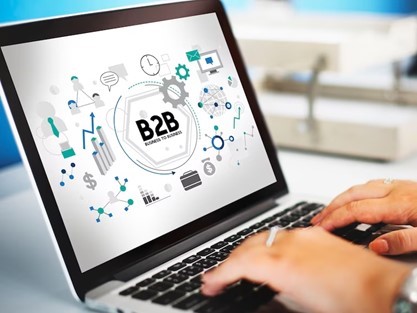The development of Information and Communication Technologies (ICT) and the growth of the Internet in recent years has changed the life and economy of society, and today, e-commerce business models are moving the world.

The major changes in sales and marketing models are a response to new needs and consumption habits, which year after year have been adapting to faster and easier for consumers.
According to Statista, by 2020, almost 90% of the world’s population will have made purchases on the Internet, reflecting the growing importance of technology for business, driving a significant change in the organization of companies and promoting their participation in the digital era.
The development of technologies such as process automation, cloud computing and the Internet of Things (IoT) brings significant benefits to companies such as cost reduction, optimization of operations and improved customer experience.
In this way, technological advancement drives greater operational efficiency in companies and enables experimentation with new eCommerce business models, here we will explore each of these.
Learn how to maximize eCommerce success via operations monitoring and support.
What are e-commerce business models?
E-commerce business models explain the relationship between companies and their direct customers for the purchase and sale of products remotely over the Internet:
- Mobile applications: Apps specifically designed for mobile devices to facilitate shopping. Examples include the Amazon shopping app, the eBay app, and brand-specific apps like the Nike or Adidas apps.
- Online stores: Websites set up by businesses to sell products or services. Examples include BestBuy.com, Zara.com, and countless others.
- Social networks: Platforms like Facebook, Instagram, and Pinterest where businesses can set up shops or run ads to direct users to their online stores.
- Email Marketing: Businesses send promotional emails to subscribers or potential customers, often with links to purchase products or special offers.
- Chatbots and Virtual Assistants: Automated systems or AI-driven helpers on websites and apps that assist users in shopping, answering queries, or directing them to purchase pages.
As eCommerce business models leverage the advantages of the Internet to boost sales beyond the physical limitations of traditional commerce, they also face the challenges associated with security and quality assurance.
Thus, the two major drivers of eCommerce businesses are trust and customer loyalty.
C2C Model: Consumer to Consumer
The C2C e-commerce model allows consumers to conduct buying and selling transactions directly with each other, without business intermediation, through digital platforms.
It has established itself as one of the most popular eCommerce business models because it is simple and low-cost, and it allows for the sale of used products such as clothing, electronics, and furniture. This channel is also used for promoting services, exchanges, and product auctions.
In this business model, logistics and customer service are generally managed by the seller independently, which has driven the rise of some C2C platforms such as:
- eBay: One of the most well-known online auction and shopping websites where individuals can buy and sell a variety of goods and services worldwide.
- Craigslist: A classified advertisements website with sections dedicated to jobs, housing, for sale, items wanted, services, and more.
- Etsy: A platform focused on handmade or vintage items and craft supplies. It’s a favorite among artisans and crafters.
- Facebook Marketplace: A feature on Facebook that allows users to list items for sale, and potential buyers can browse these listings and contact sellers.
- Poshmark: A social commerce platform where users can buy and sell new or used clothing, shoes, and accessories.
- OfferUp: A mobile-first platform that allows users to buy and sell items locally.
- Vinted: A platform dedicated to second-hand fashion, allowing users to sell, buy, or swap clothing items.
- Depop: A social shopping app where individuals can buy and sell unique fashion items, often vintage or second-hand.
These platforms have made it easier for individuals to connect with potential buyers, facilitating peer-to-peer transactions and promoting a more circular economy.
C2C Advantages and disadvantages
eCommerce business models are most commonly used by retailers, entrepreneurs or for those who have limited merchandise and do not manage a brand.
Here are some advantages of C2C business:
- Ability to sell products that are no longer needed or used.
- Allows to generate extra income.
- Lower prices.
- Possibility of getting discontinued, old or unique products.
- Can be started with little capital.
- Direct communication and transactions.
Some disadvantages of C2C businesses are:
- Credibility, since the customer may or may not have a guarantee or support during the transaction.
- Increased competition.
- It is a business model susceptible to scams.
- Difficulty in resolving disputes.
Some valuable tools for e-commerce, learn how to boost your business with CommerceTools and ChatGPT.
C2B Model: Consumer to Business
Unlike the traditional B2C model, the C2B business model allows consumers to offer their products and services directly to companies. In this scheme, it is the consumers themselves who dictate the commercial conditions such as price, terms and form of payment.
A common modality is where professionals such as designers, illustrators, programmers or even influencers use C2B platforms to offer their services independently to support specific needs that companies may have.
Although it is not limiting, it is common for this business model to work through platforms that function as intermediaries. Some C2B platforms are:
- Upwork: One of the most popular platforms where freelancers from all over the world, including designers, programmers, and writers, offer their services to companies and entrepreneurs.
- Fiverr: Similar to Upwork, Fiverr allows professionals to offer their services in packages or “gigs”. It’s especially popular among graphic designers, musicians, and voice-over artists.
- 99designs: Specifically for designers, where companies post their design needs and designers submit their proposals. In the end, the company chooses the design they like the most and pays the selected designer.
- Influencity: A platform that connects influencers with brands. Influencers can register, showcase their stats, and be contacted by companies looking to promote their products or services.
- C2B Solutions: A platform that focuses on connecting consumers who have innovative solutions with companies seeking those solutions.
- Kickstarter: Although it’s better known as a crowdfunding platform, it allows inventors and creatives to present their projects to a global audience, and companies often back projects they find interesting or useful.
These platforms have revolutionized the way professionals and consumers interact with businesses. The C2B model has empowered individuals, allowing them to set their own terms and conditions, and has provided companies with a wide range of talents and solutions to their specific needs.
C2B Advantages and disadvantages
The C2B business model has gained popularity as the demand for remote work increases, making it an attractive model for small businesses and new professionals.
Before starting in the C2B business, its advantages and disadvantages should be known.
Advantages of the C2B model:
- Viable option to generate extra income.
- Possibility to trade products or services without forming a business.
- Access to a global network of professionals and companies.
- Improved value for money.
- Savings in fixed contracting costs.
Disadvantages of the C2B model:
- Risk of non-compliance.
- Dependence on intermediary platforms.
- No control over the process, deadlines and quality.
- Greater competitiveness.
- Problems for the integration and follow-up of tasks.
B2C Model: Business to Consumer
Of the e-commerce business models, B2C, from business to consumer, is the most common and is used by companies, from the smallest to giants like Amazon and Netflix.
Given its characteristics, the B2C business is usually focused on the mass consumer market. Therefore, the priority is to work based on new needs and ensure that the product purchase and delivery process is increasingly fast and effective.
According to Investopedia, there are 5 B2C business models:
- Intermediaries: Where a company acts as an intermediary between consumers and product or service providers.
- Community-based B2C: Here, companies use communities to build relationships with consumers who share interests, sharing relevant content, promoting interaction, and obtaining feedback.
- Subscription: The company charges consumers a fee to access its products or services.
- Direct: Where companies sell their products or services directly through their website.
- Advertising-based B2C: This is a type of marketing where ads are used to direct traffic to the landing page. Its goal is to increase brand awareness, generate leads, and drive sales.
B2C Advantages and Disadvantages
For companies looking to reach a large number of consumers, the B2C model may be the right choice. However, factors such as audience, budget, and inventory must be considered.
Here are the advantages of B2C business models:
- Convenience and speed for consumers.
- Reach a wide audience.
- Adaptation of products and marketing to consumer preferences.
- The B2C model is efficient for achieving business growth.
Among the disadvantages of B2C business models are:
- It may require significant costs and investment.
- B2C companies are subject to regulations.
- Consumer mistrust regarding data security and privacy measures.
Intelligent search and optimization technology can do a lot for your digital business. Here’s the basics on e-commerce search technology, AI, and ChatGPT. How can they benefit your business?
B2B Model: Business to Business
B2B e-commerce business models refer to commercial transactions that are conducted directly from business to business, without intermediaries.
Participants in B2B eCommerce typically include:
- Wholesalers: Businesses that sell products in bulk to other businesses, which then resell to the end consumer.
- Manufacturers: Companies that produce goods and sell them to retailers or other businesses.
- Distributors: Entities that buy products from manufacturers or wholesalers and distribute them to retailers or other businesses.
- Software and Technology Providers: Companies that offer software solutions, platforms, or tech services to other businesses.
- Supply Chain Management Companies: Businesses that manage or provide logistics, transportation, and supply chain solutions for other businesses.
- Bulk Raw Material Suppliers: Entities that provide raw materials, such as metals, chemicals, or agricultural products, to manufacturers or producers.
- Industry-specific Equipment Providers: Companies that sell machinery or equipment tailored for specific industries, like construction or manufacturing.
- B2B Marketplaces: Platforms like Alibaba or ThomasNet where businesses can list and sell their products to other businesses.
- Consultancy and Business Services: Firms that offer expert advice or services in areas like management, finance, or marketing to other businesses.
- Service Providers: As you mentioned, these are businesses that offer specialized services to other businesses, which can range from IT services to HR solutions.
Companies engaged in B2B e-commerce provide services or goods that other businesses use as inputs for their operations, such as: raw materials, logistics, software, human capital, and consultancy.
Transactions in B2B commerce do not involve consumers or the general public. Moreover, the companies that participate in this trade operate on a large scale, so B2B transactions tend to have higher value and complexity.
B2B Advantages and Disadvantages
According to Shopify, by 2030 the B2B e-commerce market is expected to grow by 20%, creating more opportunities for businesses worldwide. This growth will be driven by several factors, such as the adoption of digital technologies, globalization, and the increasing demand for specific products and services.
B2B e-commerce offers a number of advantages for businesses, including:
- Long-term business relationships.
- Greater efficiency by implementing automation in management and business processes.
- Streamlining the purchasing and shipping process of products.
- Higher transaction volume.
Disadvantages of B2B e-commerce:
- Requires initial investment, personnel, and web development.
- May involve multiple parties for the negotiation process.
- Companies may need to use advanced technology and integrated systems.
- Transactions are subject to regulations.
E-commerce Models: Understand the differences between C2C, C2B, B2C, and B2B
Each of the e-commerce business models has its own peculiarities. In the following comparative table, we will describe the main differences of the four most commonly used models today: C2C, C2B, B2C, and B2B.
| Objective | Participants | Type of Transaction | Products/Services |
|---|---|---|---|
| C2C | Trade of products or goods | Two consumers: 1. Seller 2. Final Consumer | Between consumers |
| C2B | Sell products and services to companies | 1. Seller 2. Company | From consumer to company |
| B2C | · Meet the needs of consumers · Profit from the transaction | 1. Supplier Company 2. Final Consumer | Simple from company to consumer |
| B2B | Establish business relationships between companies | Two companies: 1. Supplier 2. Customer | Commercial between companies |
Source: NULogic
Did you know that ChatGPT is impacting digital commerce? Here are the details.
E-commerce Business Models – Conclusion
E-commerce is transforming the way individuals and businesses exchange products and services. Its evolution is due to the integration of processes into the digital ecosystem through emerging technologies such as blockchain, artificial intelligence, machine learning, and virtual reality.
This evolution has given rise to a new industry with new types of jobs and disruptive ways of marketing. Although its importance is implicit, we list 3 reasons that have led eCommerce to transform the world:
- It offers businesses a new way to reach consumers.
- Consumers have greater convenience and flexibility during the purchasing process.
- E-commerce helps businesses reduce costs and improve efficiency.
Given its growing global adoption, it is essential for companies to adopt technological solutions that put them at the forefront of digital transformation because the future of commerce is increasingly anchored to platforms, applications, and digitized business models.
At NULogic, we are committed to boosting the growth of your eCommerce. We have a multidisciplinary team that will guide you in implementing technological solutions for your business.
Reach out to us at NULogic, and let’s take your eCommerce to the next level together!


